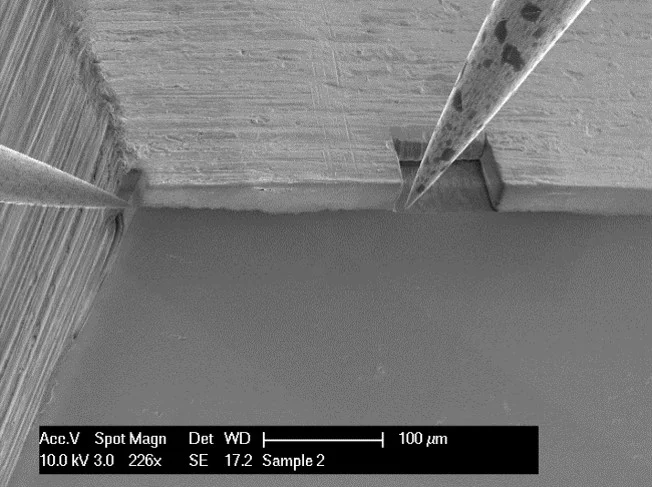A new method for direct electrical conductivity measurements at nanoscale
In this study the conductivity/resistivity of oxide formed on Zircaloy-2 nuclear fuel cladding is measured.
The same cladding grade (LK3/L) is used to compare the oxide formed after short and long residence times, respectively 3 and 9 cycles, in a Boiling Water Reactor (BWR). The oxide in the vicinity of the metal-oxide interface is studied. The measurements were carried out using a novel technique developed at PSI, using micromanipulators (micromanipulator) inside a FIB/SEM to probe different thicknesses of oxide and hence directly measure the resistance and calculate the resistivity of that thickness of oxide.
The results from the 3 and 9 cycle oxides are compared. It is demonstrated that the resistivity of the oxide in the vicinity of the interface of the 9-cycle cladding increases with distance from the interface, much faster than that of 3-cycle cladding to a maximum level. The study is correlated to previous work, performed at PSI, characterizing these 2 materials by EPMA and other techniques.
Oxide conductivity measurement on spent fuel
- Hydrogen deteriorates the mechanical properties of fuel rod cladding
(possible problem for handling and transport of spent fuel after long dry storage) - Low resistivity of the protective oxide reduces the H-uptake
- Direct measurement of the conductivity would deliver critical info for the validation of models
Experimental new findings:
The resistivity of the oxide at the metal interface increases with distance from the interface
- the structure of the oxide layer near the interface is critical for H-pickup
Nb-containing alloys show lower resistivity in the oxide close to the metal interface
- better performance with respect to hydrogen pick-up (I.e. lower HPUF)
The resistivity in the oxide close to the metal interface increases with reactor time
- higher hydrogen uptake late in life
Relevance: the model is better understood, new influences on cladding development.
Sousan Abolhassani (retired)
Johannes Bertsch
Laboratory for Nuclear Materials (LNM)
Paul Scherrer Institut
E-mail: johannes.bertsch@psi.ch
Original publication
Jonathan Hawes, Adrienn Baris, Yu-Lung Chiu, Sousan Abolhassani, Characterization of the conductivity of metal-oxide interface of zirconium based fuel cladding at low and high burnups, Journal of Nuclear Materials 534 (2020) 152133
DOI: https://doi.org/10.1016/j.jnucmat.2020.152133
https://www.dora.lib4ri.ch/psi/islandora/object/psi:31719
Publication List
- S. Abolhassani, et al., Corrosion and hydrogen uptake in zirconium claddings irradiated in light water reactors, in: Zircon. Nucl. Ind. 17th Int. Symp. ASTM STP 1543, vol. 1543, 2015, pp. 540-573.
- R. Vanta, S. Abolhassani, M. Dadras, Examination of semiconducting properties of oxides in the vicinity of metal-oxide interfaces for selected alloys, Eur. Microsc. Congr. 2016 Proc. 399 (1) (2016) 382-383
- Baris, et al., Chemical and microstructural characterization of a 9 cycle Zircaloy-2 cladding using EPMA and FIB tomography, J. Nucl. Mater. 504 (2018) 144-160.
- S. Abolhassani, R. Restani, L. Hallstadius, Comparative analysis of the evolution of Zircaloy-2 cladding irradiated in BWR, Top Fuel React. Perform. 2015. Conf. Proc. Poster (2015) 272-298.
- Baris, Increased hydrogen uptake of zirconium based claddings at high burnup, in: A Thesis Submitt. To Univ. Birmingham Degree Dr. Philos. Sch. Metall. Mater. Univ. Birmingham, No. March, 2019.
- Baris, S. Abolhassani, Y.L. Chiu, H.E. Evans, “Observation of crack microstructure in oxides and its correlation to oxidation and hydrogen-uptake by 3D FIB Tomography – case of Zr-ZrO 2 in reactor, Mater. A. T. High. Temp. 3409 (2017) 1-8.
- A.W. Colldeweih, A. Baris, P. Spaetig, S. Abolhassani, Evaluation of mechanical properties of irradiated zirconium alloys in the vicinity of the metal-oxide interface, Mater. Sci. Eng., A 742 (2019) 842-850. April 2018.
- S. Abolhassani, et al., TEM examinations of the metal-oxide interface of zirconium based alloys irradiated in a pressurized water reactor, J. ASTM Int. (JAI) 2 (6) (2005), 12390.
- M. Chollet, et al., Synchrotron X-ray diffraction investigations on strains in the oxide layer of an irradiated Zircaloy fuel cladding, J. Nucl. Mater. 488 (2017) 181-190.
- S. Abolhassani, G. Bart, A. Jakob, Examination of the chemical composition of irradiated zirconium based fuel claddings at the metal/oxide interface by TEM, J. Nucl. Mater. 399 (1) (2010) 1-12.


